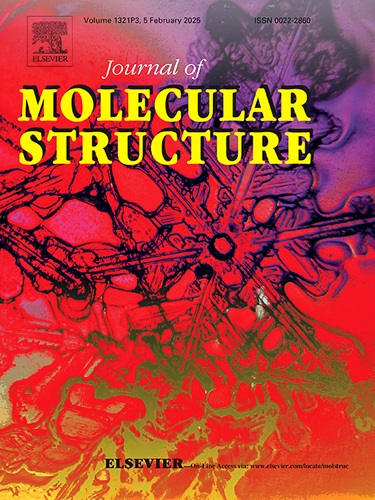绿色合成嵌入壳聚糖-果胶聚合物复合材料的Pd纳米颗粒作为高效纳米催化剂参与Suzuki-Miyaura偶联反应并加速骨关节炎关节软骨修复
IF 4
2区 化学
Q2 CHEMISTRY, PHYSICAL
引用次数: 0
摘要
采用简单有效的合成方法制备了一种新型高效纳米催化剂CS-Pec/Pd NPs。该纳米催化剂在促进各种芳基卤化物与苯硼酸的铃木反应中表现出优异的性能和可重复使用性。壳聚糖-果胶(CS-Pec)基质作为一种可靠的生物模板,促进了Pd纳米颗粒的原位还原和稳定,而不需要有害的化学物质。Pd(0)纳米粒子均匀地分散在CS-Pec的功能化表面。采用FT-IR、FE-SEM、EDX、TEM、eds元素图和XRD等先进技术对纳米催化剂进行了详细表征。CS-Pec/Pd NPs纳米催化剂在Suzuki-Miyaura偶联中进行了测试,显示出良好的官能团相容性,并持续实现良好到高收率的联苯产物。此外,该纳米催化剂表现出优异的催化活性,即使在多次反应循环后也能保持较高的效率,突显了其作为可持续和可回收催化剂的潜力。CS-Pec/Pd NPs成功地抑制了损伤部位的异常血管生成和纤维化。组织学检查显示,由于CS-Pec/Pd NPs的存在,软骨细胞增殖和软骨基质合成增加,异常血管形成减少。研究表明,CS-Pec/Pd NPs的应用在三周内加速了损伤后的恢复过程。此外,我们强调了CS-Pec/Pd NPs在受控实验室环境中促进软骨发育的有利影响。在免疫学领域,CS-Pec/Pd NPs表现出TNF-α, IL-1β, MMPs和p-p65表达水平的降低。与Nrf2通路相关的细胞氧化还原稳态调节可能是导致这一现象的原因。本研究的结果最终证实了CS-Pec/Pd NPs在促进骨关节炎关节软骨修复方面的有益作用本文章由计算机程序翻译,如有差异,请以英文原文为准。
Green synthesis of Pd nanoparticle embedded into chitosan-pectin polymeric composite as an efficient nanocatalyst in the Suzuki-Miyaura coupling reactions and accelerating the osteoarthritis articular cartilage repair
A new and efficient nanocatalyst, CS-Pec/Pd NPs, was developed using a simple and effective synthesis approach. This nanocatalyst exhibited outstanding performance and reusability in promoting Suzuki reactions involving variety of aryl halides with phenylboronic acid. The chitosan-pectin (CS-Pec) matrix acted as a reliable bio template, facilitating the in situ reduction and stabilization of Pd nanoparticles, all without the need for harmful chemicals. Pd(0) nanoparticles were evenly dispersed over the functionalized surface of CS-Pec. Detailed characterization of the nanocatalyst was carried out using advanced techniques, including FT-IR, FE-SEM, EDX, TEM, EDS-elemental mapping, and XRD. The CS-Pec/Pd NPs nanocatalyst was tested in Suzuki–Miyaura coupling, demonstrating excellent functional group compatibility and consistently achieving good to high yields of biphenyl products. Moreover, the nanocatalyst displayed superior catalytic activity and maintained high efficiency even after multiple reaction cycles, underscoring its potential as a sustainable and recyclable catalyst. CS-Pec/Pd NPs were successfully utilized to inhibit abnormal angiogenesis and fibrosis at the injury site. The histological test showed an increase in chondrocyte proliferation and cartilage matrix synthesis due to the presence of CS-Pec/Pd NPs, as well as a decrease in the formation of abnormal vasculature. The research revealed that the application of CS-Pec/Pd NPs expedited the recovery process post-injury within a span of three weeks. Additionally, we emphasized the advantageous impact of CS-Pec/Pd NPs on facilitating the development of cartilage in a controlled laboratory environment. Within the field of immunology, the CS-Pec/Pd NPs exhibited a reduction in the levels of TNF-α, IL-1β, MMPs, and p-p65 expression. The cellular redox homeostasis modulation linked to the Nrf2 pathway may be the cause of this phenomenon. The findings of this study ultimately validated the beneficial effects of CS-Pec/Pd NPs in enhancing the restoration of osteoarthritis articular cartilage
求助全文
通过发布文献求助,成功后即可免费获取论文全文。
去求助
来源期刊

Journal of Molecular Structure
化学-物理化学
CiteScore
7.10
自引率
15.80%
发文量
2384
审稿时长
45 days
期刊介绍:
The Journal of Molecular Structure is dedicated to the publication of full-length articles and review papers, providing important new structural information on all types of chemical species including:
• Stable and unstable molecules in all types of environments (vapour, molecular beam, liquid, solution, liquid crystal, solid state, matrix-isolated, surface-absorbed etc.)
• Chemical intermediates
• Molecules in excited states
• Biological molecules
• Polymers.
The methods used may include any combination of spectroscopic and non-spectroscopic techniques, for example:
• Infrared spectroscopy (mid, far, near)
• Raman spectroscopy and non-linear Raman methods (CARS, etc.)
• Electronic absorption spectroscopy
• Optical rotatory dispersion and circular dichroism
• Fluorescence and phosphorescence techniques
• Electron spectroscopies (PES, XPS), EXAFS, etc.
• Microwave spectroscopy
• Electron diffraction
• NMR and ESR spectroscopies
• Mössbauer spectroscopy
• X-ray crystallography
• Charge Density Analyses
• Computational Studies (supplementing experimental methods)
We encourage publications combining theoretical and experimental approaches. The structural insights gained by the studies should be correlated with the properties, activity and/ or reactivity of the molecule under investigation and the relevance of this molecule and its implications should be discussed.
 求助内容:
求助内容: 应助结果提醒方式:
应助结果提醒方式:


